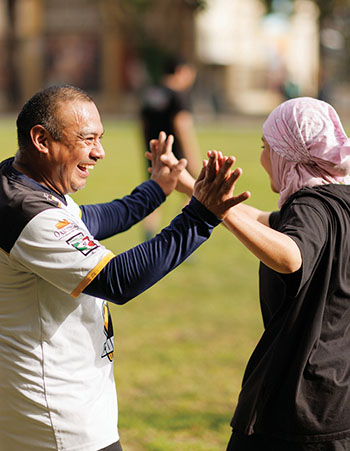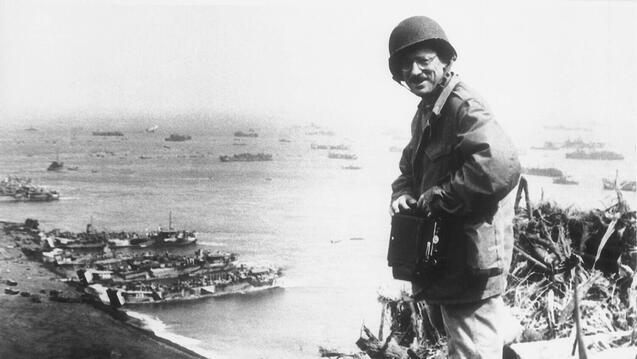

Friends Who Play Together, Stay Together
James Mannah, 69, sat covered in sweat on the sidelines of Hamilton Park’s grass field in San Francisco’s Western Addition. He had just finished a soccer game that lasted a couple of hours and while his team had lost, he, as usual, had scored a goal. Mannah has been playing soccer since he was 3 in his native Freetown, Sierra Leone. A natural striker, he has scored thousands of goals, he says with a smile, since he started playing at “the sacred field” in 1982.

For more than 40 years, soccer aficionados from every continent, save Antarctica, have been kicking off every Saturday in the Fillmore, a weekly tradition started by international students from the University of San Francisco. Over the years, the games have become about more than soccer. The friends have seen weddings, deaths, job changes, and children. But through it all, the Saturday game always kicks off between 3 and 4 p.m.
“Most of us are looking forward to Saturday afternoons like children,” says Raul Fernandez, from Mexico, a relative newcomer who found the game in 2002.
Mannah moved to San Francisco in the early 1980s to pursue a master’s degree in international business at USF, where he was a student in 1982. He was out driving on a Saturday morning and noticed the group of mostly African players.
“Most of those guys were playing for the University of San Francisco soccer team, a Division I soccer team,” says Mannah. “They won some championships, too. [They were] mostly Nigerians. While they were playing here, they played for the Nigerian national team. That’s when I started playing here, in 1982.”
Most of us are looking forward to Saturday afternoons like children.”
Raul Fernandez
Godwin Odiye ’82 was a member of the Nigerian national soccer team when he was recruited to play for USF in 1978. He remembers when he found the neighborhood game.
“I started playing with them every weekend,” Odiye says. “It was fun. I really welcomed it. Because back home I could never do that, because of being on the national team.”
Odiye, who was an Olympian who played for the Nigerian team in the 1980 Moscow games, continued to play in the Saturday pickups long after graduating from USF, stopping only because of the pandemic in 2020. He is a teacher and soccer coach at College Preparatory School in Oakland.

Today, hundreds of players have spent time playing with the SF International Soccer Family, as they refer to themselves. The game counts players from almost three dozen countries. As soon as the ball starts rolling, nationalities go out the window, and the only thing that matters is the game and the camaraderie, says Mannah.
The games are not complete without a fair amount of trash talking: “You’re scared and shaking.” “Go cry on the sideline.” And a few other not-so-PG-friendly jokes.
Damian Nuñez, 48, a musician and teacher from Buenos Aires, has been playing with the team for 20 years. He moved to San Francisco to study music at San Francisco State University in 2002. Two years later, a friend invited him to play with the group and he quickly became a regular, especially after he discovered that several of his teammates also played instruments.
After the games, while some players were barbecuing and drinking beer, Nuñez and a few other musicians in the group started jamming. They created a band in 2006 that took them from the soccer field to stages throughout the Bay Area. They chose Pangea FC as their name, a reference to the supercontinent that, millions of years ago, grouped the Americas, Europe, Asia, and Africa. The name reflected the group’s composition of musicians from California, Madagascar, Italy, Chile, and Argentina.
It was like a family to me. I just fit in. It’s like home. Everybody was looking forward to that Saturday game.”
Godwin Odiye ’82

Community Supports One Another
The “sacred field,” as Mannah and other players call it, is actually two fields: the Raymond Kimbell field between Scott and Steiner streets, where Mannah started out playing, and the field across the street at Hamilton Park, where the team moved in 2002. It is one of 171 fields across San Francisco. Hamilton is surrounded by the Western Addition library to the west and a recreation center to the east with a swimming pool and basketball and tennis courts.
The players — bankers, lawyers, cooks, engineers, and others — turn to one another for help with jobs, raising money for someone in need, or hiring entertainment.
When Mannah needed an activity for his annual fundraiser to build schools in Sierra Leone, he didn’t have to look far. Pangea FC became the headliner at the benefit at El Rio, a bar in the Mission.
During the more than two decades he has been part of the community, Fernandez says he has seen everything: Births, marriages, baptisms, birthdays, and, inevitably, deaths.

Raduan Sadrane, a player from Casablanca, Morocco, who has been playing with the team since 1989, still remembers losing a player who was struck and killed by a car.
“I bought these beautiful Diadora soccer shoes, but they were too tight. I played one game or two, and they didn’t break in easily, so I gave them to him,” says Sadrane. “He was an awesome guy. I still remember the guy’s face.”
The group took another hit three years ago with the passing of another — not a player but a member of the extended soccer community.
“Jackie Lafferty was the grandfather of the family, an old-timer from Scotland and his wife from Japan. Very sweet people. They were our elders, and we always treated them as such, with much love and respect,” says Fernandez. “I’m describing how playing soccer is therapy for myself, but I think for other people, like Jackie, too, who just happen to live in the neighborhood.”
Lafferty, who came to watch the games and drink a beer or two, died three years ago in his early 90s, but his departure left a big void in the group, says Fernandez. “He adopted us, and we adopted him. It was a loving relationship with our grandpa and grandma.”

New Players Continue Tradition
Odiye remembers playing at USF and in the weekly Western Addition games with Andy Atuegbu ’77 and his brother Fidelis Atuegbu ’81. Andy Atuegbu was a star midfielder from Nigeria who helped the Dons win the NCAA championship in 1975 and 1976.
“I kind of miss all the arguments, the different opinions, finding out who knew what was happening,” Odiye says. “It was like a family to me. I just fit in. It’s like home. Everybody was looking forward to that Saturday game.”
Sitting on the sidelines after a game, Mannah looked on and talked about playing with an older generation. Those who are playing now are involved, he says, because “their fathers would bring them here.”
“When they grow up, they play with us, and it just keeps evolving,” he says. “The same thing is happening right now.”
This article first appeared in Mission Local, a news site based in the Mission District of San Francisco at missionlocal.org. Mary McInerney contributed to this article for publication in USF Magazine.









